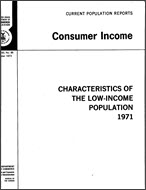Characteristics of the Low-Income Population: 1971
Characteristics of the Low-Income Population: 1971
This report presents social and economic statistics for the population of the United States below the low-income level in 1971, based on the March 1972 Current Population Survey (CPS). Included are data on selected characteristics of the population below the low-income level in 1971, such as geographic distribution, race and ethnic origin, family status, size of family, education, employment status, work experience, occupation, income (including type and source), and income deficit. Several historical tables detailing a picture of the changing composition of the population below and above the low-income level since 1959, the first year for which low-income data are available, are also presented. A description of the population below the low-income level in 1971 and some analysis of changes in the composition of this population over the past year and since 1959 are included.
Families and unrelated individuals are classified as being above or below the low-income level, using the poverty index adopted by a Federal Interagency Committee in 1969.1 This index centers around the Department of Agriculture's Economy Food Plan and reflects the different consumption requirements of families based on family size, sex and age of the family head, the number of children, and farm-nonfarm residence. In order to keep the poverty index constant over time, the thresholds are updated annually based on changes in the Consumer Price Index. The low-income threshold for a nonfarm family of four was $4,137 in 1971, $3,968 in 1970, and $2,973 in 1959. See page 17 for a detailed explanation of the low-income definition. In the text of this report, the terms "low-income" and "poverty" are used interchangeably.
__________
1 For more detail, see Social Security Bulletin, January 1965; "Counting the Poor: Another Look at the Poverty Profile," and Current Population Reports, Series P-23, No. 28, "Revision in Poverty Statistics, 1959 to 1968."
A Note on Language
Census statistics date back to 1790 and reflect the growth and change of the United States. Past census reports contain some terms that today’s readers may consider obsolete and inappropriate. As part of our goal to be open and transparent with the public, we are improving access to all Census Bureau original publications and statistics, which serve as a guide to the nation's history.
Others in Series
Publication
Publication
Publication




